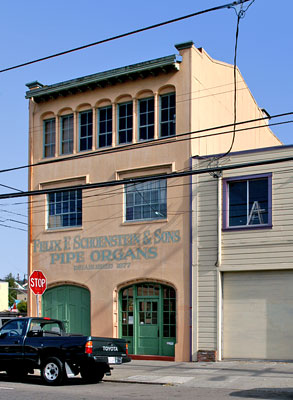San Francisco Landmarks
Schoenstein Organ Factory
3101 20th Street
Inner Mission
Built 1928
The following is adapted from the final case report of the San Francisco Landmarks Preservation Advisory Board dated 16 April 1977:
Leo Schoenstein started building organs in Germany before 1850. His sons began building orchestrions in 1864. (An orchestrion is a mechanically played organ similar to barrel organs.)In 1868, two of Leo's sons came to San Francisco to install an instrument in a beer garden on Jackson Street near Portsmouth Square. One of the sons, Felix worked for pioneer California organ builder Joseph Mayer for eight years.
Felix left Mayer in 1877 to establish himself in business at 512 Birch Street. In the early days, he installed orchestrions for the Cliff House, Woodward's Gardens, Maier's Beer Garden and others in addition to his service work in churches and residences. His early record books show many calls to the Nob Hill residences of Stanford and Hopkins among others. The firm built its first full-scale pipe organ in 1881 for St. Mary's church in Stockton.
Since then, about 75 complete instruments have been designed and built by the firm, the last in 1967. Except for the metal pipes, all components of the Schoenstein organs were built in the firm's own shops in comparison to many small builders who are really assemblers of components ordered from a catalogue.
Of Felix's ten children, three sons - Louis, Otto and Erwin - became involved in the business, which was reorganized as Felix F. Schoenstein & Sons about 1909. The other sons were involved in the organ business in other cities.
For most of its first hundred years, the firm was the largest organ builder in the West. It is the third oldest builder in the United States. Most of the City's historic instruments are under its care, including those in Trinity Episcopal Church, Philadelphia Seventh Day Adventist Church, and Holy Cross Church, Congregations Sherith Israel and Emanu-El, and two municipal buildings: The California Palace of the Legion of Honor and Civic Auditorium.

Although the family sold the company in 1977, the new owner retained the name Schoenstein & Co. and continued to manufacture pipe organs here until 2004.
The building is now owned by a high-tech company. For more information, see National Register Listing 78000759.
